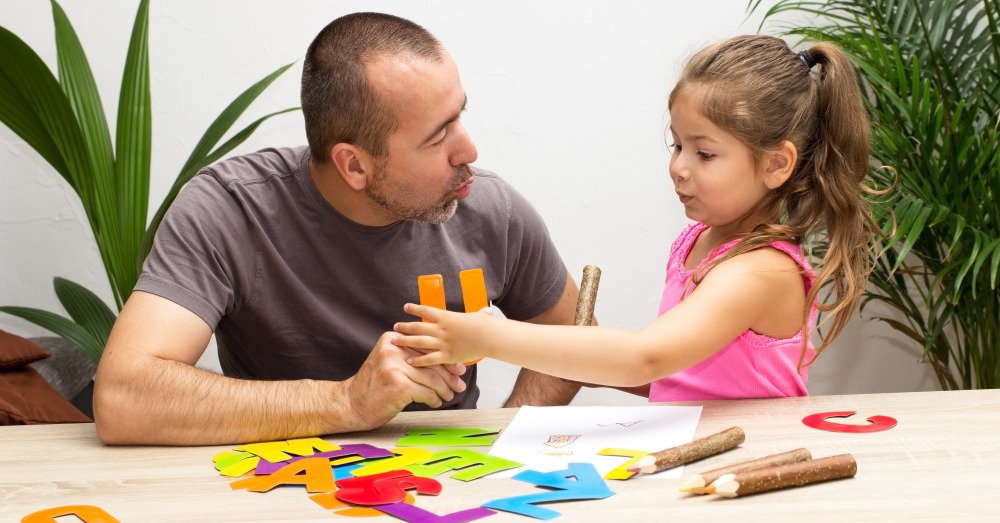
Autism and Echolalia: What You Need to Know
Have you ever noticed that your child or loved one tends to repeat words and phrases, whether from you, TV, movies, or other people? There’s actually a special term for that, and it’s called echolalia—the mimicry of words or phrases.
Imitation is a pretty normal part of human development; babies and toddlers use it as they learn language. However, those with autism may use it well past their toddler years and continue it into childhood, teenagehood, and even adulthood.
But what purpose does echolalia serve? How should parents or caregivers respond to it?
Before we dive into any of that, you first need to know that there are a few different types of echolalia.

The two categories of echolalia
Typically, echolalia is divided into two different categories: immediate and delayed.
Immediate echolalia is when a person mimics something they just heard. For example, if you ask your child, “Would you like some juice?” he or she may engage in immediate echolalia by replying “Like some juice?” in the same intonation.
Delayed echolalia, on the other hand, is when an autistic person hears something and later repeats it at another time. For example, a child may occasionally repeat favorite quotes from a movie or TV show.
Echolalia can also be interactive and non-interactive, as well as unmitigated (repeated verbatim) and mitigated (a word or two is substituted within a phrase).
The Various Purposes of Echolalia
Once upon a time, it was believed that echolalia was an autistic behavior that served no purpose. Now we know that it can serve some important functions. Here are a few examples…
1. Taking time to process what was said
Immediate echolalia in particular buys the autistic person time while they process what was just said and figure out a response. Neurotypicals do something similar to this, as well. If someone asks you a thought-provoking, personal question, like “What’s something you wish you’d known five years ago?” you might use mitigated echolalia by saying, “Hmm…something I wish I’d known five years ago…” as you think about your response to the question.

2. Engaging in conversational turn-taking
This happens when an autistic person wants to reciprocate in a conversation but may not have the words to create novel statements and responses. For example, a person who asks an echolalic child, “What did you do over the weekend?” may receive a response like “Don’t forget to pack your sunscreen!” because the child heard that phrase before going to the beach on Saturday. Or going back to the “Would you like some juice?” example, immediate echolalia can be used as a way of saying “yes.”
3. Stimming and self-soothing
A function of non-interactive echolalia can be simply for the fun of it or to calm oneself down during times of stress.
4. Expressing a mood
If a person on the spectrum is excited, they may say something like, “Please keep your arms inside the roller coaster ride at all times!” Why? Because they heard this phrase when they were excited at an amusement park. Repeating what was said during a time they felt similarly can be a way to express their current mood.
5. Making a request
For example, a child on the spectrum who hears “Got milk?” from a commercial may use this phrase in the future to ask for a drink.
6. Staying focused
Echolalia can also be used to keep an autistic person on task and focused. For example, a person who has been asked to feed the dog may repeat, “Feed the dog” to keep themselves on track and avoid getting distracted.
How to Respond to Echolalia

If your child is using echolalia, this is a great sign; it indicates they might be able to move on to form novel sentences in the future (although some people do communicate through echolalia for life). They can do this with help from a speech therapist and the people in their life, like you.
In essence, this might involve giving the individual the words they don’t have and teaching them the correct way to say things through prompting or modeling.
For example, you may say, “What is the color of your dog?” and immediately follow up with “white.” Or if you see your child struggling to reach something, model what they might want to say with “I would like some help, please” and then help them out.
(This is just to give you an idea of how it works, by the way. To learn more, please consult a speech therapist.)
What about non-communicative echolalia, like that which is used for stimming? You’ll probably want to treat this like you would any other case of stimming. Our recommendation: as long as they aren’t saying anything bad or mean, and as long as the echolalia is not interfering with daily life or disruptive, it’s best to just leave them to it and let them have their fun.
Want to know more?
Check out this episode of Amythest Schaber’s “Ask an Autistic” to learn about echolalia from an autistic point of view!